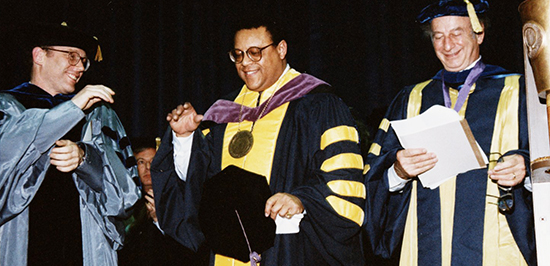Throwback Thursday: A New Day
 |
|
H. Patrick Swygert, center, at his formal inauguration on April 5, 1991. He is flanked by physicist William Lanford, chair of the University Senate, at left, and Spanish scholar Frank Carrino, the grand marshal. (Photo courtesy of UAlbany Archives) |
ALBANY, N.Y. (October 26, 2017) — A UAlbany milestone in diversity was achieved on July 1, 1990, when H. Patrick Swygert became the institution’s first African-American president.
A professor of law and executive vice president at Temple University, Swygert came to UAlbany with notable and multifarious credentials. He had been a visiting professor of law at the University of Ghana and Tel Aviv University. He’d been a general counsel to the U.S. Civil Service Commission and special counsel to the U.S. Merit Systems Protection Board. He was active on several civic commissions for the City of Philadelphia and the State of Pennsylvania.
In his five years as president, which concluded when he became president of his alma mater, Howard University, Swygert initiated many major changes. With the state’s share of operating funds declining, he launched the Campaign for Albany, the first fundraising initiative of its kind for the University, which successfully raised $55.3 million.
Swygert was literally groundbreaking, as well. Under him, construction began on a two-pronged extension to the Campus Center, which would connect years later to the new Science Library. (The library broke ground just after Swygert's departure.)
Seeking additional research space that would in turn spur regional economic growth, he announced plans in 1993 for a 75,000 square-foot Center for Environmental Studies and Technology Management. Known as CESTM, it was completed in 1997 and houses to this day UAlbany’s Atmospheric Sciences Research Center. Swygert's efforts overall increased the University's visibility in the region and the recognition of the University as an economic force. He commissioned the campus's first-ever economic impact statement.
Swygert also witnessed the construction and opening, in 1992, of a Recreation and Convocation Center ("the RACC"), now the SEFCU Arena, the institution’s first true athletic field house.
Organizationally, he reconstituted the College of Arts & Sciences, which had been divided into three separate divisions in the late ‘70s, and received state approval to reestablish doctoral degrees central to a research university: history, English and philosophy.
One of his major initiatives to encourage and advance student excellence was the establishment of the Presidential Scholars Program in Fall 1993.
His vision of a university was reflected in a new Mission Statement, which he commissioned in 1992. It reaffirmed the traditional goals of a public research university, but added several emphases. The University, it said, should foster the ideals of justice, hold fast to the ideals of freedom of thought, inquiry and expression, and seek to profit intellectually from differences of opinion and culture.
![]() For more news, subscribe to UAlbany's RSS headline feeds
For more news, subscribe to UAlbany's RSS headline feeds
A comprehensive public research university, the University at Albany-SUNY offers more than 120 undergraduate majors and minors and 125 master's, doctoral and graduate certificate programs. UAlbany is a leader among all New York State colleges and universities in such diverse fields as atmospheric and environmental sciences, business, education, public health,health sciences, criminal justice, emergency preparedness, engineering and applied sciences, informatics, public administration, social welfare and sociology, taught by an extensive roster of faculty experts. It also offers expanded academic and research opportunities for students through an affiliation with Albany Law School. With a curriculum enhanced by 600 study-abroad opportunities, UAlbany launches great careers.


